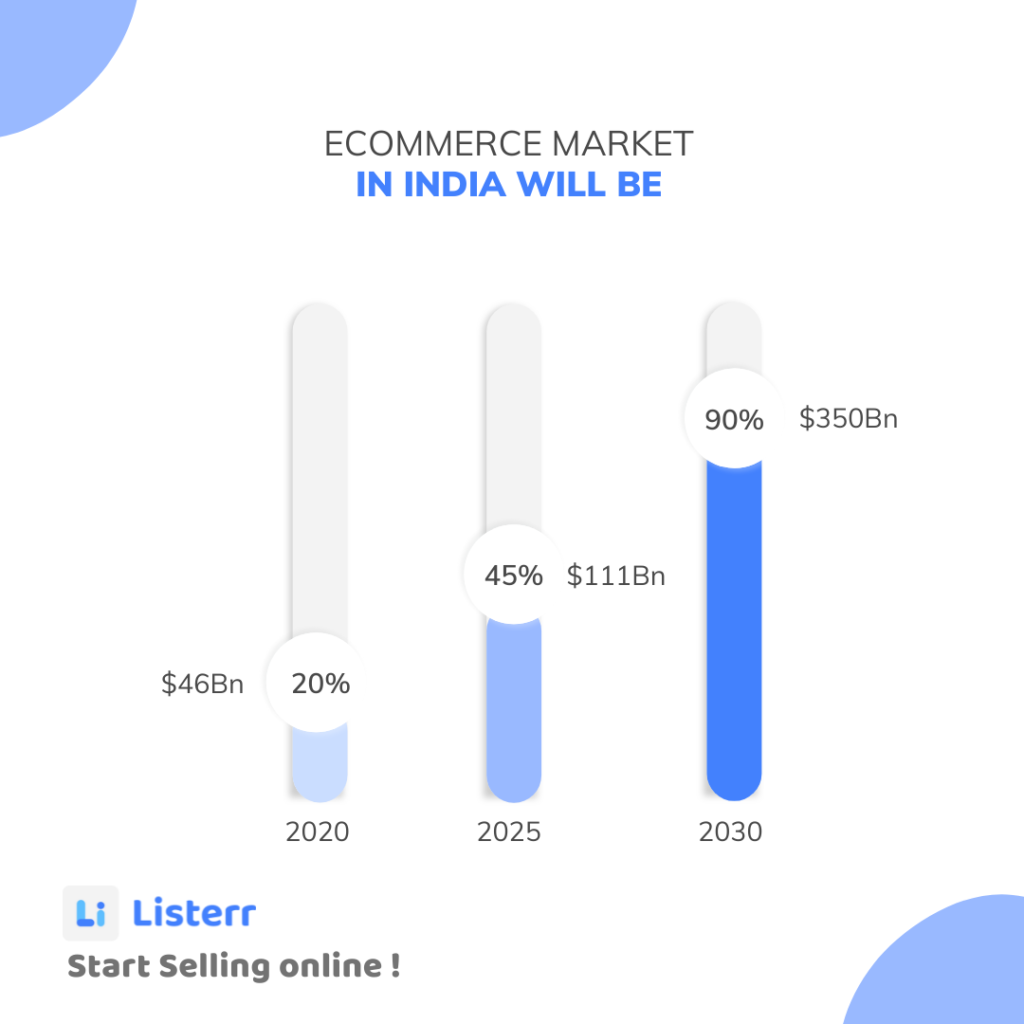
How online shopping is growing in India?
As the Indian economy is on the rise, we are also witnessing a boom of online shopping in India. The online business industry is poised to see a growth of 30% in the next three years. This has resulted in a huge number of online shopping websites being launched and the number of users are also on the rise. The e-commerce industry in India is all set to reach $12 trillion by 2023. This is the time to grab this opportunity and expand your business. At the same time, the Indian economy is growing at a steady rate. With the world’s largest population, the young population and a growing middle class, the online retail sector in India is poised for takeoff.

Indian online shopping industry stats
The Indian online shopping industry is growing rapidly. And with more than 1 billion people in India and one of the fastest growing internet user bases in the world, it has a good chance of overtaking the US in the near future. But what is the Indian online shopping industry like? How big is it? Well, we’ve dug up some quick stats you should know about the Indian online shopping industry.
- 20% of India’s internet population shops online.
- The average price of an online purchase is Rs. 1721.
- Online shoppers are expected to grow at a CAGR of 22% in the next three years.
- The Indian online shopping industry is expected to grow from $46 billion in 2020 to $111 billion by 2025.
- By 2023, online sales are expected to account by 96% between 2022 and 2025 of total retail sales in India.
- Over 49% of India’s online population shops on Amazon.
- Online shopping in India is expected to generate many jobs year on year. There is an increase seen by 22% in the ecommerce workforce in 2020 (Covid time).

How does online shopping industry work in India?
Online shopping is a system that allows buyers and sellers to meet on a common platform to facilitate the exchange of goods and services. By this, we create a buyer-seller interference in which various items are listed on the website that makes the buyer create a purchase. Altogether it works like when the buyer visits a website through any medium, maybe via mobile, laptop, or any other digital device and select the goods needed. This is how online shopping works where the buyer lists various different products on the website and make the price listed along. The main focus is on the door to door delivery which makes the consumer more comfortable and adaptable in shopping.
The best thing about shopping online is that the prices are lower than in traditional stores. This is because the seller purchases the product directly from the manufacturer, and then the retailer or wholesaler intervenes to purchase the product. The reason is that online stores require large quantities of goods and therefore require secure storage facilities. From an Owner’s Perspective: Manufacturers trade with the aim of maximizing sales and profits.

What are the challenges faced in the Indian e-commerce sector?
Indian e-commerce companies are facing a lot of challenges and here’s a look at some of them.
- Indian customers return most of the items purchased online.
- Cash on delivery is the most used payment option in India.
- Payment gateway failure rate is high.
- The quality of internet connectivity is poor in several regions.
- Feature phones still dominate the quarter.
- There is little standardization of postal address.
- Logistics is the problem in many of the Indian Towns.
- Competitors with too much money push up the cost of customer acquisition.
It is important to note that e-commerce giants are increasingly attracted to India. Cross border e-commerce to India is on the rise, and many major international players are also investing heavily in establishing businesses in India.

What are the current trends in the Indian ecommerce sector?
India’s e-commerce market has the potential to overtake more mature markets and become the world’s third largest market for $ 350 billion by 2030.
Current trends in the Indian ecommerce sector :
- Much of the industry’s growth has been driven by increased Internet and smartphone penetration. The number of Internet connections in 2021 increased significantly to 830 million, driven by the Digital India program. Of all internet connections, about 55% were in urban areas, 97% of which were wireless.
- According to a report released by IAMAI and Kantar Research, India’s Internet users are projected to grow from about 622 million in 2020 to 900 million by 2025, reaching a CAGR of 45% by 2025.
- India’s e-commerce sector received US $ 15 billion in PE / VC investment in 2021. This is a 5.4-fold increase over the previous year. This is the highest investment value ever received by any sector in India.
- In February 2022, Xpressbees became a $1.2 billion unicorn after raising $ 300 million in Series F funding.
- As of February 15, 2022, the Government e-Marketplace (GeM) portal had 9.04 million orders worth 193,265 crores (US $ 25.65 billion) from 3.79 million registered sellers and service providers to 58,058 buyers was processed.
- According to a ****Bain & Company report, India’s total commodity value (GMV) of social trade was about $ 2 billion in 2020. It is projected to reach $ 20 billion by 2025, and due to high cell phone utilization, it could jump to $ 70 billion by 2030.

How the growth of the Indian online shopping industry will affect you?
Today, India is the third largest base for over 140 million online shoppers, behind only China and the United States. Not long ago, shopping meant spending lazy Sunday afternoons at malls and markets, going from one store to another. Now, simply search the web for your favorite e-commerce portal and make online purchases with just a few clicks.
Over the past two years, a series of lockdowns and social distancing norms have disrupted the Indian retail sector a bit, causing e-commerce to surge. Without access to a physical market, people were forced to use online platforms to make purchases. Online shopping has become a lifeline for both retailers and consumers. This has affected in many ways the Indian retail industry, which is one of the largest industry in the world.
While the overall retail market shrunk, the outbreak of the COVID-19 pandemic has also accelerated the adoption of e-commerce and m-commerce as people from all walks of life began using the internet to purchase essential and non-essential goods. Therefore as I said before, India is the third largest base for over 140 million online shoppers, behind only China and the United States.
The growing preference for digital shopping channels is challenging the status quo. There is little doubt that e-commerce adoption was already on the rise before the pandemic hit, especially in large and Tier 1 cities, but the pandemic has made retailers realize the many benefits of digital platforms. It not only provide new opportunities to attract new customers, but it can also reduce operating costs.

The smart strategy to adopt for your ecommerce business in India
India is one of the most promising e-commerce markets in the world. The online retail industry in India is expected to grow at a compounded annual growth rate (CAGR) of 24.5% over the period 2016-2021. With an estimated worth of $111 billion by the end of 2025, it is ranked as the sixth largest e-commerce market in the world. It is also expected to be the third largest by 2020 with a projected worth of $46 billion. As of now, the Indian e-commerce industry is largely dominated by international retail giants like Amazon, eBay, and Flipkart. However, with the rising number of internet users, this trend is expected to change in the near future. Even though most Indians are still wary of online shopping due to security concerns, increasing internet penetration and smartphone penetration is expected to change the scenario.
Here are some of the strategies that can be used to increase your online sales :
1. Raise Customer Service
Research shows that when customers receive good service, they tell two or three people about the company. Customers are the heart of any business, which is why it’s important to provide personalized customer service. The happier your customers are, the more often they return to your brand and store. 86% of Indian customers value customer service over the actual product. When you become available and show them you really care, they will start to trust you.
For this, you can monitor customer feedback. You can use some of the tools like :
a. Ask nicely
b. Typeform
c. UserReport
2. Be active on Social Media
One of the benefits of an e-commerce business is that it already has an online presence. All you need to think about is how to connect with the right audience at the right time on the right platform. Social media is the backbone of D2C brands and e-commerce companies that sell services and products directly to customers. Customers are searching for brands on a variety of platforms these days, making it important to be active on social media. Increase opportunities to engage with your customers on social media platforms. Two social media platforms that cannot be ignored are Facebook and Instagram. Proper marketing and promoting your products on Facebook and Instagram will make the right impression on your customers. Share content that resonates with your audience and avoid posting randomly on these platforms.
3. Make Your eCommerce Website easily operable through mobile
The use of mobile devices for online shopping and website browsing has increased tremendously. In fact, as of October 2021, over 113 million shopping apps have been downloaded. Optimizing your e-commerce site for mobile users can also increase your chances of making a sale. People love to shop on the go these days, and missing out on mobile Commerce customers means missing out on tons of revenue and profits.
Even if you don’t want to invest money in an app right away,your website should be mobile friendly to meet the needs of mobile users. Make it easy for your customers to navigate your e-commerce site regardless of the device they use. Make your e-commerce website content digestible for a variety of users.
4. Recommend, But in a Finer Manner
Research shows that probability is much more higher to sell to existing customers than to new customers. If you want to sell a new product or service to a new customer, your chances of making a sale are only 5-20%, but your chances selling to existing customers increase by 60-70%.
Product recommendations can increase sales and revenue, so it’s important to know when and how to recommend products to your customers. Showing your product at the right time increases the chances that your product will sell, but showing an up sell pop-up at the wrong time can make your customers abandon their cart or leave your website. It takes less than a second.
5. Give a Smooth Checkout Experience
When a customer makes a purchase online, there are a few steps that must be taken before payment can be made. An online store can’t change a customer’s mind if they don’t like a product, but they can save them an unpleasant experience at checkout.
Checkout pages often require customers to fill out multiple forms in her fields. Well, this is annoying and he’s one of the reasons for abandoning carts. Checkout should be seamless and ideally personalized. This requires expertise in checkout.

Conclusion
The Indian online shopping industry is the second largest in the world, but there are a lot of people who know very little about it. The e-Commerce sector in India is booming and there are many opportunities to capitalize on. We hope this blog post has been informative and helps you to educate others on the Indian e-commerce industry. If you would like to learn more about the Indian online shopping industry, please visit https://listerr.in .
Buy OnlineListerr - An Indian MarketplaceOnline ShoppingSell onlineshop online

